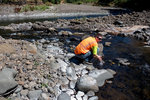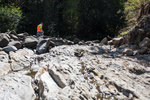




While most large water systems in the Lewis County area have reported they’re handling the drought well, some small systems are seeing concerning water levels.
Sue Kennedy, senior environmental health specialist for the county’s water program, said the problems are primarily with springs and hand-dug single family residence wells.
She said while people on those systems are used to low water levels later in August, they are seeing low levels now. Kennedy has received a few phone calls on the issue, but declined to provide a figure on how many people may be experiencing issues.
Residents experiencing low water levels can contact Lewis County Public Health and Social Services, which will provide information about a loan program through U.S. Department of Agriculture Rural Development to drill or repair wells.
For more information about the program visit www.rd.usda.gov/wa.
Napavine Urges Water Conservation
Napavine’s municipal water system includes 709 current water users, including residential and commercial properties, said City Clerk Penny Jo Haney.
The city’s water supply is groundwater and officials are continually monitoring the supply.
At this time no measures to conserve water have been put in place by the city, although public works staff said Napavine’s normal policy is to always encourage water conservation.
Staff said at this time the water supply is not threatened by the ongoing drought.
Tenino Slightly Concerned Over Levels
The city of Tenino’s current water level sits at 16 feet from the wellhead, causing “just a little bit of concern” for Dave Defoe, the city’s public works director. With groundwater as the city’s main source, he said anytime levels drop below the 20 foot mark he begins monitoring the supply closely.
Although there is some concern, he said that even if the dry spell lasts longterm, the city should be OK. Last year, water levels resembled what the city is experiencing now.
So far, no measures have been put in place to conserve water, but Defoe said citizens in town were overall conserving well.
“There’s a lot of brown lawns in town,” he said of the conservation efforts.
If a problem were to arise, Defoe said, the city would stop irrigating the city park and school district properties, and would shut down the Tenino Quarry Pool since it requires extra water to run.
The municipal water supplies about 660 customers.
Pe Ell Asks Residents to Be Responsible
Pe Ell’s municipal water system serves about 350 hookups and draws water from Lester Creek, said Pe Ell Mayor Lonnie Willey.
The city is keeping an eye on water levels, but the drought hasn’t caused any real problems yet, Willey said.
“So far we’re doing pretty good … our water flow is still good,” he said. “We’ve asked the residents to conserve.”
Willey said the city has asked residents to use water responsibly, and to avoid using any more water than they need to when irrigating plants and yards.
“When I talked to my water supervisor last week, he thought as long as people are careful and work together, we’ll be ok,” he said.
If the drought continues and Lester Creek gets too low to supply water to the town, Willey said the city has backup plans.
“We can draw out of the (Chehalis) River, but the river is so low,” Willey said. “If we had to, we could.”
Boistfort Valley Water Watches Flows
The private Boistfort Valley Water system serves 3,000 customers, with about 800 connections to area homes, said system operator Sean Hamilton.
The system pulls surface water from the Chehalis River and Mill Creek, he said.
“Right now, mostly we’re just having to make plans if the drought continues,” he said. “The flows are slowing down a bit.”
Hamilton said the water system has started sending letters to customers asking them to conserve water. The letter asks them to avoid watering lawns during the hottest portions of the day and to avoid washing cars and other unnecessary uses of water.
While water levels are dropping, demand for water is increasing, Hamilton said. More people have had to irrigate their lawns and gardens this year, since there has been so little rainfall.
Hamilton said the system is not in any real danger from the drought.
“We feed primarily from the Chehalis (River)” he said. “It’s really doubtful that’s going to go dry.”
If it needs to, Hamilton said, Boistfort Valley Water can also draw water from Stillman Creek.
“We’re looking pretty good at the moment,” he said. “If this compounds into next year we’ll have some issues.”
No Water Woes for Winlock
Winlock’s system draws its water from four wells, and excess water is stored in two 300,000-gallon tanks.
Water Superintendent Rod Cecil said the city isn’t storing any extra water at this point, and well levels are checked daily.
“Everything is where it should be,” he said about the system’s water table.
He said the system has a lot of old piping, so crews are regularly repairing leaks as soon as they find them.
In comparing well levels throughout the year and with records, Cecil hasn’t seen any issues and doesn’t think any problems will arise for Winlock during the drought. He doesn’t expect residents will need to start conserving water.
“If all the sudden … this whole next year it didn’t rain at all it might then lead to an issue, but I don’t foresee that happening,” he said.
Cowlitz River Provides Enough Water for Vader
The Vader-Enchanted Valley Water System, which has 369 hookups, draws its water from the Cowlitz River.
“The Cowlitz seems to be doing fine right now,” Lewis County Public Works Director Tim Elsea said.
The dams on the river have regulated releases from the reservoirs, and those releases provide enough water for Vader’s surface water system.
“We haven’t even started voluntary conservation at this point,” Elsea said. “The system is not being stressed.”
Elsea said the county doesn’t foresee any issues with Vader’s water system during the drought, but that could change, he said.
He added that daily water usage increased as temperatures reached high points this summer, but it has gone back down to normal levels.
The county has been operating Vader’s drinking water system for more than a year. Since taking on the system, the water loss due to leaks has been reduced from 60 percent to 20 percent.
Toledo Slightly Below Historic Averages, but Doing Well
Toledo Public Works Superintendent Craig McCown said while the city’s water system levels are slightly below historical averages, it has enough water to make it through the drought.
“We have plenty of storage; our demand is very small compared to how much we keep in the tank,” he said.
The city currently keeps between 210,000 and 235,000 gallons. It is in the process of putting in a new tank that will double its storage. Average daily use during the summer months for its about 335 hookups is between 50,000 and 70,000 gallons.
McCown said Toledo also has a low leakage rate of less than 10 percent water loss due to proactive efforts.
The city draws its water from an aquifer located between Roberts Lane and state Route 505. About 90 percent of the city’s water comes from one well with another small well providing the rest. In the past 10 years, the city has gone from producing about 25-30 million gallons of water annually to 18-19 million.
McCown credits the reduction in production to people conserving water or wanting to save money on their bills.
“I think on the whole people are doing a great job as far as conserving the water,” McCown said. “... I don’t see a lot of people out there watering the lawns.”
He said he doesn’t think Toledo will ask users to take any conservation measures because the aquifer isn’t showing signs of failure.
Centralia Aquifer Lower Than Usual, Still Fine
As it currently stands, Centralia’s water supply is low but doing ok.
“I’m not looking at an emergency conservation declaration at this time. I am preparing to ask people to not waste water,” said Centralia Public Works Director Kahle Jennings.
The city’s water source is an aquifer. It measured at 3-3.5 feet below average at one of the city’s main wells and 7 feet below average at another. Jennings said those numbers could change in August after the Public Works Department reports on the city’s water supply.
The city also has a well that has remained offline for some time, but will be coming on in the beginning of August.
“We believe getting it online will mitigate any concerns that might come up,” Jennings said.
Centralia also has surface water rights on the Newaukum River, but it hasn’t been used for some time since the reservoir slid off of Seminary Hill in 1991.
Chehalis Public Works Happy About Brown Lawns
Chehalis Public Works Director Dave Vasilauskas said Chehalis is doing pretty well. The city draws its water out of the Newaukum and also has rights on the Chehalis, if need be. On July 13, he told the Chehalis City Council that in 2013 the city filtered 620 million gallons of water and 680 million in 2014. But as of mid-July the city had only filtered 304 million gallons. He said the river readings for July compared to three years ago were right on track for 2015.
He told The Chronicle on Monday the flows out of the Newaukum are at 2.5 million.
“At the moment, if we keep the current flows, everything coming out of the river is close to historicals,” he said.” For the most part we’re able to keep with the system demands.”
On average, the city draws 1.6 million gallons of water per day. Usage in the summer are heavier because of watering lawns and crops and everyday usage.
“It’s nice to see all those brown lawns; people aren’t watering them much,” he said.
Morton Stressing Conversation, Taking Precautions
Keith Cournyer, Public Works superintendent for the city of Morton, said his department has been doing what it can to spread public awareness of the city’s water supply. Morton doesn’t have any water restrictions in place currently, but it is asking people and businesses in the community to be conservative with their water use.
“The amount of water we have available is lower this time than most other years,” he said. “Morton is doing OK, we’re just really stressing the conservation.”
The city gets it water from Connelly Creek, just a little ways outside of town on state Route 7. It also has an emergency well that it can use to augment the water supply if it becomes necessary. Finally the city does also have emergency water rights on the Tilton River, on which Public Works is developing a pump system should the need ever arise.
“Just last year the issue came up. We went ahead and did (get the pump). Honestly, I don’t think we’re going to need it but good to know we have it,” Cournyer said.
Mossyrock Practically Floating Away
Of all the communities in Lewis County, Mossyrock is probably the least concerned about its water supply.
“We are fortunate in the water department,” he said.
According to Mayor Tom Meade, the city asks its residents to watch their usage and get any leaks they may have repaired. The city is also going to start doing more data collection on the levels of its two aquifers.
“But that’s just a precaution thing,” he said. “It’s never been an issue having two relatively large reservoirs nearby — at least it’s never been.”
Mossyrock is also selling bulk water to people and organizations outside the city, including Lewis County Fire District 3 and Lewis County Public Works.